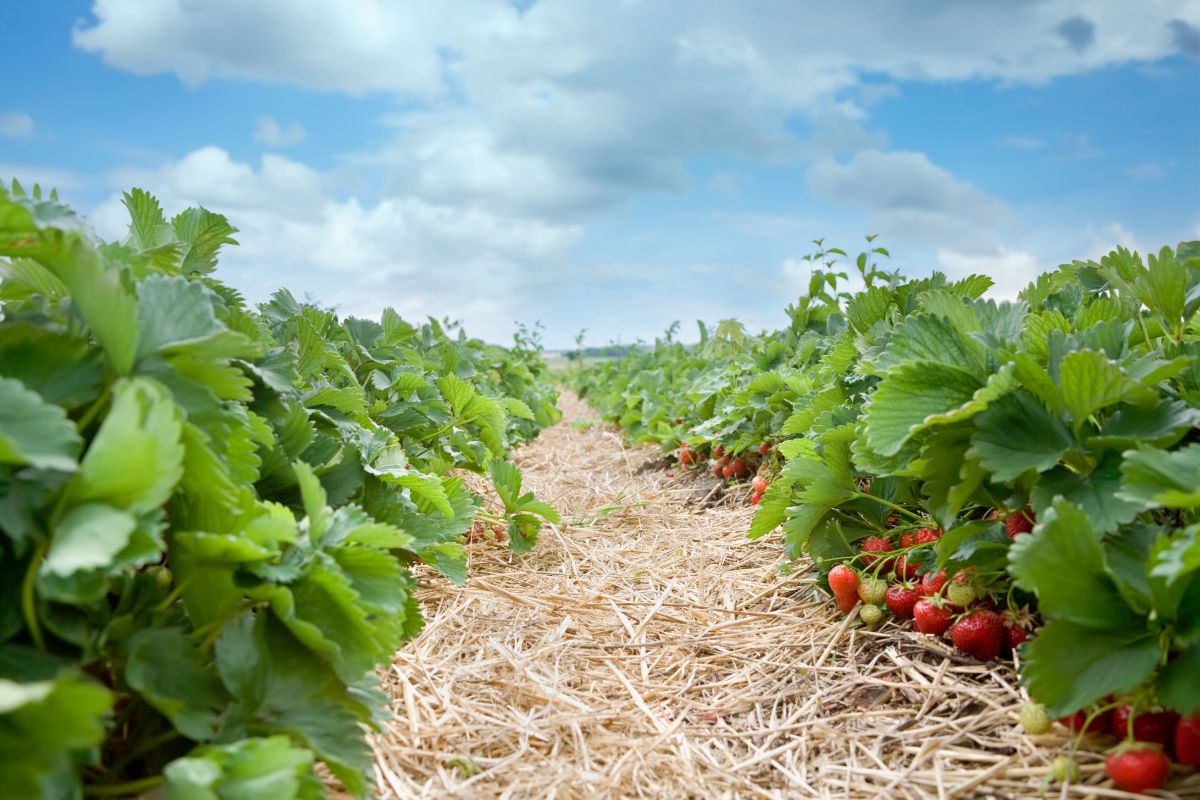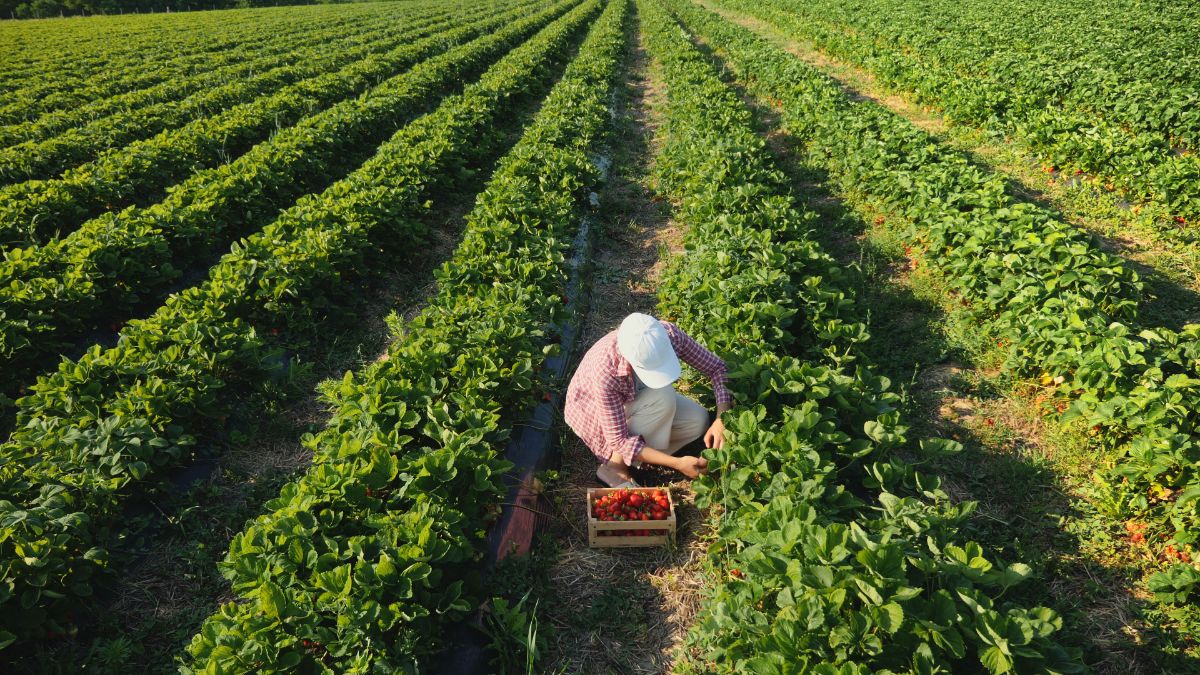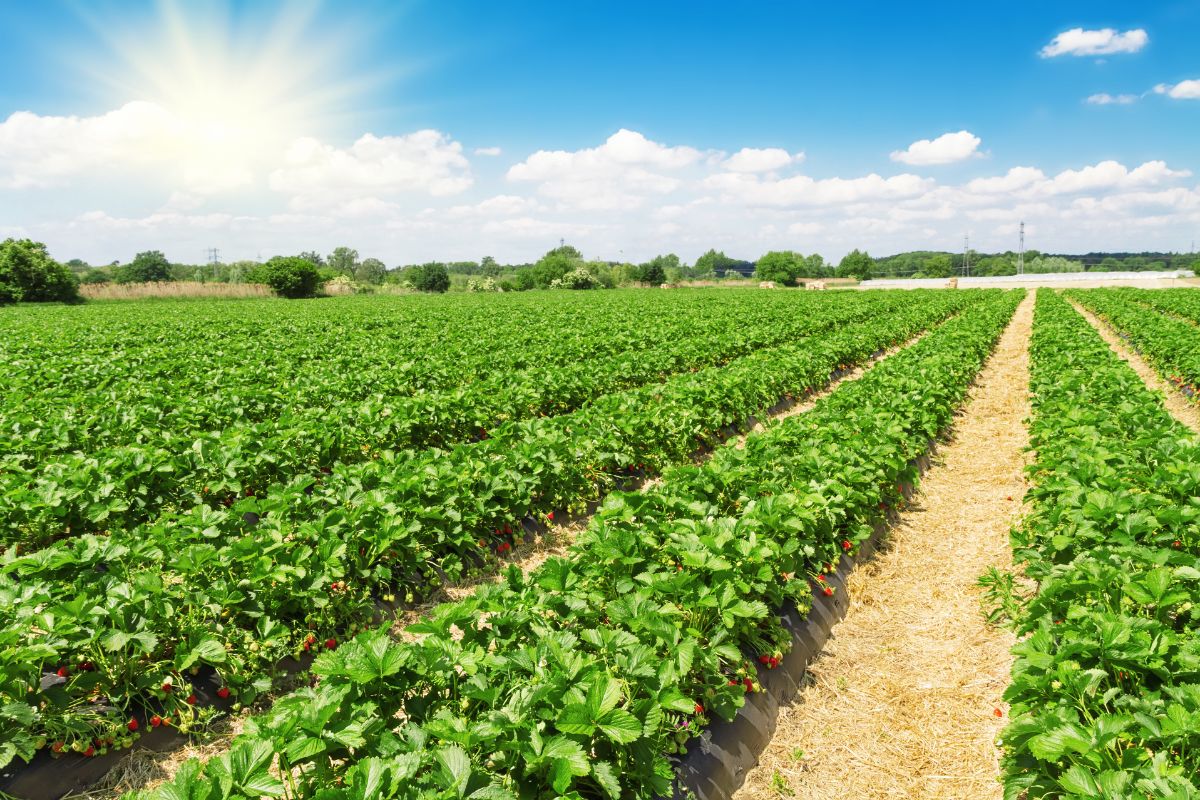The matted row system of growing strawberries is decades old. It was developed after the modern Garden Strawberry became the dominant strawberry grown (see the Strawberry Plant reference page for more details). Growing strawberries in the matted row system has multiple benefits. Chief among them is increased yields over all but the modern commercial methods.

By using the matted row, gardeners and some commercial growers can take advantage of the unique characteristics of strawberry plants in order to get the most out of their land, out of their effort, and for their taste buds. This post is an introductory article to the matted row system.
Jump to:
How Growing Matted Row System Strawberry Plants Works
The matted row system is an old method of growing strawberries that has been used with great success by a host of commercial and Pick-Your-Own strawberry farms. It is also commonly used in regions that have a colder climate. In this strawberry production method, strawberry plants are set out on cultivated and fertile bare land at regularly spaced intervals within regularly spaced rows. This initial planting is allowed to grow, send forth intertwining strawberry runners, and establish those daughter plants within the row. This interlaced and crisscrossed network of runners creates a matted tangle of strawberry plants, hence the name “matted row.”

The matted row system takes a full year (12 months) before a crop is harvested. This is why the newer plasticulture methods have become popular as they make possible a harvest in as little as 7 to 8 months after planting. The cost of purchasing strawberry plants, however, is usually much lower than with newer methods. The matted row system allows the strawberry plants to multiply themselves into the rows to maximize production. Each planted strawberry plant will multiply its production by sending out and establishing daughter plants that will produce its own strawberries for harvest the following spring. Further reducing planting costs is that fact that the matted row strawberry system makes the most of the perennial nature of strawberry plants. Each matted row is allowed to produce until the plants lose their productive ability, which is usually between 2 and 4 years.
One of the drawbacks of the matted row system is that the strawberries require tending all year long. The strawberry renovation process must be done each year after harvest, and, of course, the strawberries have to be harvested by hand. However, if growing your own strawberries, this last chore can be quite pleasurable as those fresh strawberries are sampled to make the work easier!
Matted Row System Strawberry Varieties

There are a few different types of strawberry plants that are commercially available. Day-neutral and Everbearing strawberry plants are best grown in systems other than the matted row system. The matted row is most appropriate for growing June-bearing strawberry varieties (for a detailed explanation of the differences, see the Strawberry Varieties reference page). Virtually any June-bearing strawberry cultivar will do well in matted rows. Some of the more popular varieties for planting in matted rows are: Allstar, Delmarvel, Earliglow, Honeoye, and Jewel. To find a supplier of the variety for which you are looking, see our directory of suppliers who sell online and offer Strawberry Plants for Sale.
Details of Growing Matted Row Strawberries
It takes 12 full months after planting strawberries in the matted row system to see a full crop ready to be harvested. But, since the rows will usually produce for multiple years, the initial time sacrifice can be recuperated in subsequent years. The details of spacing of both rows and plants can be found by following the link below in the conclusion. Typically, one can expect between 6,000 and 8,000 pounds of strawberries to be produced per acre of land planted with strawberry plants using the matted row system. To determine the appropriate number of strawberry plants to purchase per acre of land to be planted based on spacing, see the table on this post: strawberry plants per acre.
The Matted Row System: Conclusion
Using matted rows is likely the best option for home growers and hobby gardeners. It minimizes annual costs and maximizes garden space. The matted row can also be adapted for square foot gardens by allowing the matted row to become a matted square, usually planting one strawberry plant per square foot in the initial planting and allowing the runners to populate and fill the rest of the 4×4 square. For much more guidance on the matted row system, including helpful diagrams, visit the Growing Strawberries reference page. There you can also find other systems better suited to the other types of strawberry plants.
Good luck! Feel free to come back and share your experiences with growing strawberries with the matted row system by using the comments feature below.










Manisha Dhungel says
I want to cite this article. how can I do that ?
Mary Ward says
Please name the site and create a live link to this article. If you need to cite it for a bibliography, there are many online references to help you do that. There are also citation apps. (I like the Cite This for Me extension)
Vegas gardener says
I’m in Las Vegas and just bought 4 Junebearing plants to plant in containers. It’s been a lobg time since I planted strawberries so I’ve been reasearching how best to plant them, however when I bought them they already had blooms and have strawberries fruiting. I just hardened them over the past 3 days and was thinking about planting on Wednesday, but now want to know if I should be picking off the blooms and fruit no yet ripened. It’s hard to do as I LOVE strawberries but should I do this to get a better June harvest?
Mr. Strawberry says
Vegas gardener,
No, you should not pull off the blooms to get a better June harvest this year. You won’t get any harvest if you snip the blooms now. Usually it is best to snip your plants’ blooms this year for better results and higher total overall yield in subsequent years. However, if your plants were already potted and growing well when you bought them, they are likely established well-enough already to produce for you. So, I’d just take care to water them appropriately and eat what they produce! Good luck!
Hoby Strawberrer says
What happens if you just plant the strawberries anytime of the year. Do I harvest after any respective 12 months?
Mr. Strawberry says
Hoby Strawberrer,
If you plant in the spring, you should wait until the following spring for June-bearing varities. For everbearing and day-neutral varieties, you can harvest the second crop in the fall. For all strawberry plants planted in the fall, you can harvest the following spring. Good luck!
Roger Savain says
David,
How do you layout for August planting in NC. Can I use a BCS 853 or what equipment to make rows and put plastic.
David says
Hello,
You said that: “The matted row system takes a full year (12 months) before a crop is harvested.”
we usually plant strawberries in August. If I choose to plant june bearing varieties in the matted row system, then the fruits will appear for example in May/june? So, we harvest after 9 to 10 moths after planting. Isn’t it? or even june bearing varieties will need a full year and give fruits in august? Is that possible?
Please help!
Mr. Strawberry says
David,
Most people plant strawberry plants at the same time as they plant the rest of their garden: in the spring. Spring-planted strawberries take a full year to bear a full harvest of strawberries. However, if you plant June-bearing strawberries in the matted row system, you can harvest in May/June like you mentioned. Fall planting is actually ideal for strawberries due to their natural life cycle. In fact, you can order them towards the end of summer from these retailers: Fall Strawberry Plants.